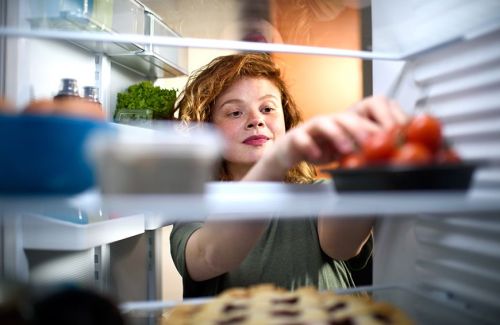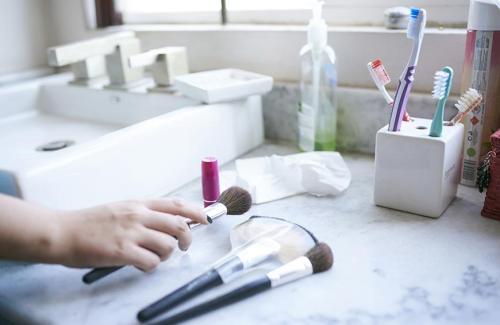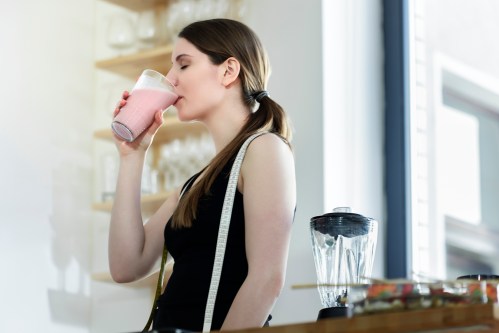Our editors independently select these products. Making a purchase through our links may earn Well+Good a commission
I became weirdly plastic-phobic after reading an article about how sperm counts have decreased by 50 percent in 40 years, and how there is some expert consensus that this change is likely due to neuroendocrine disruptors like the BPA found in plastic. (And also, receipts.) Now, why do I care about sperm counts as a lady (who is not trying to conceive)? Perhaps because reproductive issues are seen as sort of the canary in the coal mine when it comes to health—meaning, they are often the first sign that something in our bodies is going wrong. And while science may not be 100-percent settled in terms of plastic’s effects on our systems, health isn’t the only reason it makes me cringe.
Not long after reading that article, I was fortunate enough to take a trip to the Maldives, an island nation in the Indian Ocean. No plastic was allowed on the island I visited, and I actually noticed…meaning, I’m so used to seeing plastic littered all over natural environments and washing up on shore that I actually noted its absence. This stressed me out—and for good reason. According to the Plastic Pollution Coalition, eight million tons of plastic enter the ocean annually, and a recent study showed that by 2050, there will be more plastic than fish in the ocean. This isn’t just bad for the marine life—for whom it’s really bad—it’s also bad for those of us who consume them (and, you know, the overall ecosystem of the planet).
When I started to notice—really notice—all the plastic in my life, I became overwhelmed. To help clean it up, I called zero-waste expert Lauren Singer
Here’s where you might be thinking: “But what about recycling?” The truth here is harsh. According to the Plastic Pollution Coalition, only 9 percent of plastic is recycled. When I speak to Program Manager Jackie Nunez, she tells me that the bulk of what we throw into the blue bin ends up in the landfill. One big reason for this is that we used to sell our plastic waste to China, but they stopped taking it. Additionally, most people don’t understand that throwing one wrong thing into the bin—Nunez calls this “wish-cycling,” as in “This seems recyclable”—can contaminate the whole bin and destine its contents for the landfill. (There are many additional contributing factors here—detailing them would require a separate article but suffice it to say, our recycling system is not in a good place!)
What’s more, recycling is a misnomer. “Recycled” plastic is actually down-cycled, says Nunez, and once the product your water bottle’s been converted into reaches the end of its lifespan, it goes to the landfill. Plastic does not go away.
And, it’s everywhere. When I started to notice—really notice—all the plastic in my life, I became overwhelmed. To help clean it up, I called zero-waste expert Lauren Singer. She offered some immediate reassurances. “It’s one of those things that from a zoomed-out lens you’re like, ‘Holy f*ck, how am I going to do this?’ But it’s not that bad,” she tells me.
Wanna see what she means? Keep reading to find out what actually happens when you try to detox your life from plastic.

Upon initial inspection, I find that plastic is most ubiquitous in the kitchen and the bathroom, particularly in single-use form, e.g. a shampoo or condiment bottle. When I talk to Singer, she tells me to focus first and foremost on these items and worry less about those with longer lifespans, such as the plastic storage bins beneath my bed or my luggage.
It’s a lot. I decide to eat the frog and start in the kitchen.
Condiments
In the kitchen, condiment bottles are the most glaring examples of my single-use plastic addiction. Singer provides me with a few options for eradicating them, the first of which recurs throughout our conversation and reiterates that eliminating single-use plastic from your home (and life) is more of a major lifestyle change than it is an exercise in good habits. “For the most part, I’ve pretty much eliminated all of them,” she tells me of her condiment collection. “The biggest thing I like to do is ask myself, ‘Do I need this? Is this necessary for my happiness?’ Condiments are one of those things that are nice but not necessary.”
If you must have, say, mustard, she suggests learning to whip it up yourself. “It’s really easy to make, mayo is easy to make, ketchup is easy to make—all from natural, organic ingredients,” she says. Or, she adds, you can buy your condiments in recyclable, plastic-free containers. “If you go to a natural food store you can find mustard, mayo, etc. all in glass jars,” she says. “Buy the biggest size because those things last a really long time—the fewer containers you buy the better.”
DIY’ing condiments is one of those things I wish I would do but know I never will. Instead, I take Singer’s advice and ask myself which condiments I really need. The truth is, I don’t really “need” any of them. Sriracha has long been my main squeeze but I get along just fine without it. And if I find myself craving the condiment down the line, Singer’s right—it’s easy to make in just 15 minutes, so my “I don’t have time to DIY” excuse doesn’t really fly. In the meantime, I’m saving money (and avoiding unnecessary sugar consumption). Win.
Supplements and vitamins
Perhaps because I write a lot about health and wellness, my kitchen is stacked with supplements—everything from vitamin D to drinkable collagen, and it’s all packaged in single-use plastic. Shudder.
Here, too, Singer asks me to evaluate which among these items I really need. “I don’t take any [supplements],” she tells me. “Eat a balanced diet and you can pretty much get all the nutrition you need.”
This is something I’ve been working on anyway—sitting outside for 15 minutes a day so I can cease taking vitamin D supplements prescribed for my confirmed deficiency—but it’s a tough call-to-action nonetheless. I don’t know if I “need” my collagen. I mean, the idea that the container is going to go into a landfill just so I can maybe look slightly younger grosses me out a little. Ultimately, I decide to wean myself off of it and any other supplements save for my vitamin B12 (because I don’t eat much animal protein). Again, I’ll save money and ideally be motivated to eat as healthy as possible so as to get as many of the nutrients I was trying to supplement as possible. (Note: you can also buy supplements in glass bottles, but Nunez points out to me that downsizing—asking yourself what you really need—will help you reduce your waste overall.)
Grab-and-go food and drink
The other thing cluttering up my fridge with plastic are grab-and-go items from Trader Joe’s. I’m talking balela salad, which is my addiction du jour, bruschetta sauce, which is life-changing when mixed into eggs, hummus, and more. It’s all packaged in single-use plastic.
At this point, I know what Singer is going to say—decide whether or not you need it, and if you do, make it yourself. Well, unlike my condiments, I decide I do need these items, so I look into recipes and as it turns out, they’re all super simple and even more delicious when made fresh. I whip them up while I watch Netflix—as in, I literally chop vegetables on my coffee table. I would’ve been watching TV anyway while texting—double screens!—so this feels more productive (and slightly healthier). Regarding hummus specifically, Singer offers a second solution for those who don’t want to make it themselves—head to your nearest hummus-slinging restaurant and buy some—packaged in your own, plastic-free container, of course.
I also have an embarrassing amount of to-go containers in my fridge. Sadly, there is no easy or super-convenient answer to this one, though Singer surprises me by saying that she does order to-go food; however, she picks it up and alerts the restaurant ahead of time that she’s going to bring her own containers to put it in. This is undeniably an extra effort, one that in practice makes me realize I don’t want the to-go food badly enough to get in my car for it at least 75 percent of the time. (Seriously!) Instead, I find things to make at home—which, while not as exciting as the pad Thai I crave, serve the basic function of feeding me just fine.
To this end, Singer advises prep, prep, and more prep to prevent those moments in which you feel there’s “nothing to eat” in the house and are compelled to order takeout. As another alternative, she tells me you can aim to order from companies that use paper or cardboard materials; however, the hard truth about recycling is that if it’s got food or grease on it that can’t be rinsed away (by you, by the way), it won’t be recycled.
If you’re eating out at a restaurant, meanwhile, and want to take home your leftovers (er, food waste is a huge problem, too!), Singer suggests bringing your own containers to avoid unnecessary plastics.
As for all the other little takeaway items you may be offered throughout your day, Singer tells me it’s wise to prepare a kit to keep in your bag. “I always have a reusable coffee cup that can be used for water, too. I have a fork, spoon, knife, and chopsticks. I have a stainless steel container, which is really great for leftover food and also for compost, so if you’re on-the-go and have an apple core or something, you can put it in the container and compost it later,” she says.
Finally, I ask Singer about snacks, because I’m always running around and tend to find the only thing that keeps in my car are granola-bar type grab-and-go’s. She offers a simple solution—make them yourself and wrap them in Bee’s Wrap to eat them exactly as you would a store-bought bar.
Cleaning supplies
The area beneath my sink is a haven for plastic—this is where I keep my cleaning supplies. Though they’re largely natural products, they’re still packaged in plastic, which, for the purposes of this project, means they need to be eradicated. Singer tells me to phase them all out. “For cleaning the kitchen, you need three things,” she says. “One is a liquid Castile soap, two is baking soda, and three is white vinegar.” The Castile soap, she explains, can be used to wash the dishes, the baking soda can be used with a wet washcloth as a scrubbing agent, and the white vinegar can be used to make a cleaning spray. If you don’t like the scent, she says, you can add water and essential oils. The only other things you may need are compostable dish brushes and steel cleaning scrubbers, she explains.
Water filter
Here I was, so smug about my shunning of plastic water bottles (which are far worse for the environment than one jug, by the way) while I’m soaking my water in plastic daily in order to make it healthier. Singer tells me that when she lived in LA—where the tap water is dicey—she used a bamboo charcoal water filter.
Alternatively, you can have five-gallon water jugs delivered to your house through a subscription-type service. Many such companies reuse the plastic bottles returned to them over and over and over again, and some offer glass alternatives (if you, like me, don’t want to soak your water in plastic!). The latter is the option I selected—this is one of the only areas of the project where I decide to spend money rather than save, but clean water is priceless. I’d recommend doing extensive research before purchasing, however, as the bottled water industry is not highly regulated.
Storage and dishes
As per Singer’s advice, I replace tinfoil and plastic wrap with Bee’s Wrap and stainless steel containers. I don’t use parchment paper, but she tells me that if you do, you can replace it with a silicone slip mat “that will last a really long time.”
For cooking, she tells me you only need a few items—she uses a cast iron pot and a couple of Le Creuset pots, all of which she’s purchased secondhand and none of which contain plastic. Beyond those, she utilizes a bamboo steamer and wood cooking utensils.
I have some glass Pyrex containers with plastic lids that are fairly new, so I opt to keep them and make a mental note to replace them when they need replacing with stainless steel containers. (I don’t want to throw my new plastic into the trash, after all!) Same goes for my plastic spatula—it grosses me out, but I don’t want to add it to the landfill and I don’t use it enough to worry about its toxicity so I keep it… for now. After giving my kitchen one final sweep for plastic offenders, I move on to the bathroom.

If clearing my kitchen of plastic is difficult, the bathroom presents an ever greater test of my dedication to the cause. Again, everything within it is packaged in plastic, and unlike what I found in the kitchen, I truly believe I “need” the things contained in those bottles.
Singer insists this isn’t true and says she gets all of her beauty products from Package Free Shop. As you might expect, her routine is pretty minimal. It includes a face oil, a charcoal soap for her face and body, a natural deodorant, and either a shampoo bar or refillable shampoo and conditioner (sold on the site). A refillable lotion is also sold on the site, though Singer makes hers herself.
When I protest about the efficacy of these products versus the ones I use—especially my fancy shampoos—Singer tells me she believes this is largely marketing. “I’ve been using natural and plastic-free shampoo for six years, so I guess if you don’t like my hair, that’s your answer,” she jokes. “But that’s a choice everyone has to make.”
There’s a huge hole in the makeup market for plastic-free alternatives.
When it comes to makeup, things are a bit more difficult to replace. Singer tells me there’s a huge hole in the makeup market for plastic-free alternatives. To clean up my collection, I opt for the clean beauty brand Kjaer Weiss’ refillable foundations, bronzers, blushes, and mascaras and wooden eye pencils. I don’t wear anything on my lips, but they sell refillable lip tint and lipsticks as well.
Also potentially found in your bathroom? A plastic toothbrush. Mine is actually a Quip which is made from plastic but since my sad gums (genetics!) require I use an electric toothbrush, I’m not sure what to do about this. If you don’t need such a device, you can switch to a bamboo version. I buy toothpaste that comes from a metal tube that’s recyclable, though Singer offers that I could make it myself as well using her toothpaste recipe, which calls for coconut oil, baking soda, and peppermint essential oil, if I really want to go the distance with waste reduction. She also recommends a plastic-free dental floss alternative, which I buy.
Another thing Singer mentions, which I hadn’t even noticed when evaluating my plastic holdings, is razors. Yep, mine are plastic (and packaged in plastic). You can buy non-plastic versions without much effort, like these stainless steel ones, and replacement blades. I’m going to wait until my current supply runs out before switching.
Meanwhile, my plastic hairbrushes have lasted me a very long time (which might be gross, now that I think about it), so I wouldn’t consider them as disposable as some of the other items on this list. When they do need to be replaced, however, I will opt for non-plastic versions.
Tampons
Unsurprisingly, Singer uses a menstrual cup. They gross me out, but Singer tells me she felt the same way at first but that she’s since become “obsessed.” “There are a hundred reasons why they’re better,” she says. “[One being] that a lot of tampons aren’t cotton, they’re a cotton-poly blend, so you’re putting plastic in your vagina.”
If you can’t get onboard with the cup, she recommends organic cotton reusable pads or even washable underwear. “It’s made from plastic, but if you take care of it, it will last a long time,” she says.
TMI, but this is the one area of the project in which I’ve as-of-yet failed. I can’t get on board with dealing with my menstrual blood…yet. Instead, I use organic cotton tampons without applicators—still wasteful, but no plastic!
Prescription meds
When I ask what to do with these, Singer tells me that some pharmacies take back pill bottles; however, she doesn’t know what they do with them when they’re returned. Asking yours for details is probably your best bet, and if they won’t take them back, the bottles can be recycled in some areas but not all.
Prescription drugs are not always avoidable (hi, antidepressants!), but Singer says she does try natural remedies as often as possible instead of over-the-counter medicines, e.g. reaching for chamomile tea for a stomachache or water and a little caffeine for a headache. I was raised to avoid over-the-counter meds so for me, this one is easy minus the bottle of emergency Advil I keep on hand for the occasional “post-celebration” headache. That stays.
Contacts
If you wear contacts, Singer has some bad news—they’re made from plastic! I don’t know why this never occurred to me, but it didn’t. There’s a huge pollution problem, too, she tells me, because people are throwing theirs into the sink and they’re ending up in the ocean. I can’t quit contacts, but I can avoid flushing them into the water system. Though the packaging of each individual contact is made from plastic as well, Singer tells me that it’s at least recyclable.
Saline solution also comes in recyclable plastic, but it’s a bummer there aren’t non-plastic alternatives. Lasik has always freaked me out. (Singer says, ‘Same.’) But it’s something I may need to consider more seriously if I want to eradicate as much plastic as possible from my life.

One final area Singer says to be wary of is the closet. A lot of clothing is made from plastic—polyester, nylon, etc.—and though it’s not single-use, it ultimately still ends up in a landfill (plus, every time you wash it, plastic leeches into the environment). I buy secondhand only (outside of socks, underwear, and swimsuits) so I’m pretty clean here and decide it’s “good enough” for now.
Reducing plastic from my home ends up being largely an exercise in minimalism. “Do I need this?” is a tough question to ask yourself given how much marketing goes into telling you just how badly you need all the things you own. Ultimately, however, detoxing your home from plastic can make you healthier—more whole foods, less exposure to endocrine disruptors and synthetic chemicals generally—while saving you money.
I had to shell out some cash upfront to replace plastic in some areas of my life, but overall it seems I’ll save just by adopting a mentality of “less is more.” Detoxing is not easy, but it’s also not as hard as it seems. Now, my (hopefully, former) addiction to single-use plastic seems insane. For the sake of my health and the health of the planet, I hope it stays that way.
Need more motivation? This just in: climate change is bad news for mental health. And P.S.—most bottled water is just tap water! The more you know…
Sign Up for Our Daily Newsletter
Get all the latest in wellness, trends, food, fitness, beauty, and more delivered right to your inbox.
Got it, you've been added to our email list.










